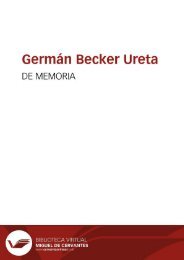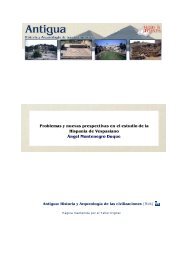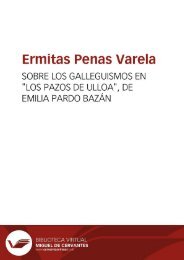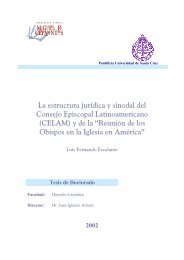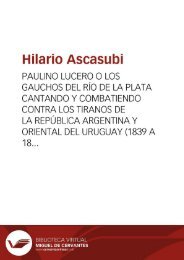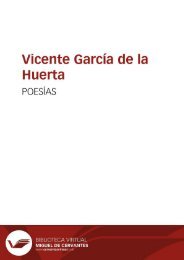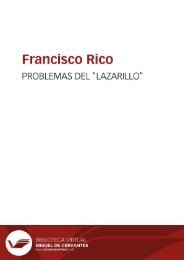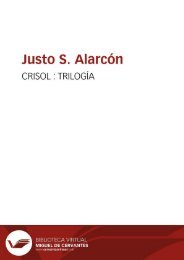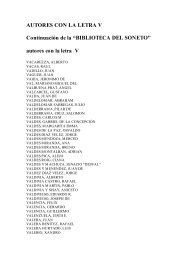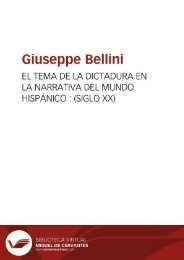You also want an ePaper? Increase the reach of your titles
YUMPU automatically turns print PDFs into web optimized ePapers that Google loves.
Anales galdosianos [Publicaciones periódicas]. Año XII, 1977<br />
projects his artistic consciousness as a thematic strain into his own novels. By that token, Correa has<br />
captured El amigo Manso's dimension as a novel about novel writing 125 . Even so, rather than fixing<br />
on it as an end in itself, Cornea treats the self-conscious aspect of <strong>Galdós</strong>' artistry as a feature of the<br />
novelist's construction of the illusion of reality. Many of the most perceptive readers of El amigo<br />
Manso have, in fact, responded to the work's suggestive treatment of the nebulous frontiers between<br />
reality and fiction. 126<br />
125 Realidad, ficción y símbolo en las novelas de Pérez <strong>Galdós</strong> (Bogotá: Instituto Caro y Cuervo,<br />
1967), esp. pp. 100-07. A propos of Felipín Centeno he says that « el autor descubría en sus personajes<br />
mismos de novela la posibilidad de sentirse ellos como seres reales, pero, al mismo tiempo, de hallarse<br />
conscientes de ser criaturas de ficción » (p. 79). Some of his introductory remarks, which he restates<br />
in his conclusion (p. 291), bear repeating here: « Nos hallamos situados, así, frente a un arte que se<br />
propone ser una representación fiel de la realidad, pero que insiste, al mismo tiempo, en su carácter<br />
estricto de ser un mundo de ficción. el hecho de convertir esta preocupación de arte en sustancia<br />
misma de novela viene a constituir una de las peculiares maneras que adopta el novelista para llevar a<br />
cabo este proceso de transformación de la realidad en un mundo de ficción. La novelística de <strong>Galdós</strong><br />
revela, así, una dimensión interior de arte que es consustancial a su propia creación » (p. 11).<br />
126 For example, Leon Livingstone, «Interior Duplication and the Problem of Form in the Modern<br />
Spanish Novel», PMLA , 73 (1958), 393-406, includes a brief discussion of El amigo Manso in support<br />
of his postulation that this technique of interior duplication and character autonomy is a statement<br />
of a relativist metaphysic in which fiction and reality have no fixed outlines. Monroe Z. Hafter's<br />
introductory remarks in «Ironic Reprise in <strong>Galdós</strong>' Novels», PMLA , 76 (1961), 233-39, might suggest<br />
that he is to take up the problem of internal repetitions of the fictional construct, but he deals, rather,<br />
with characters' reflection of each other. He extrapolates the self/other antinomy from complementary<br />
pairings cither of characters or within characters and thereby dramatizes <strong>Galdós</strong>' subtle illumination<br />
of an elusive human reality. Eamonn Rodgers, in « Realismo y mito en 'El amigo Manso' », Cuadernos<br />
Hispanoamericanos , No. 250-252 (1970-71), 430-44, aware of the frame's presence throughout the<br />
novel, takes note of Manso's mythic dimension but remains tied to a defense of the label of realism.<br />
Nancy A. Newton, « El amigo Manso and the Relativity of Reality», Revista de Estudios Hispánicos ,<br />
7 (1973), 113-25, cleverly weaves Manso's autonomy into her thematic considerations. She defines<br />
his trajectory from object-centeredness to subject-centeredness as «a dynamic act of auto-creation» (p.<br />
122) and takes note of the special textual kinship between <strong>Galdós</strong> and Manso as a «deliberate rupturing<br />
of the fictional illusion which the nineteenth-century realist novelist normally makes every effort to<br />
90



